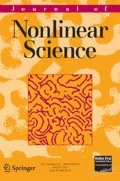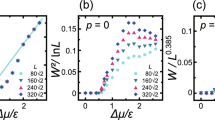Abstract
It is well known that elastic effects can cause surface instability. In this paper, we analyze a one-dimensional discrete system which can reveal pattern formation mechanism resembling the “step-bunching” phenomenon for epitaxial growth on vicinal surfaces. The surface steps are subject to long-range pairwise interactions taking the form of a general Lennard-Jones (LJ)-type potential. It is characterized by two exponents m and n describing the singular and decaying behaviors of the interacting potential at small and large distances, and henceforth are called generalized LJ (m, n) potential. We provide a systematic analysis of the asymptotic properties of the step configurations and the value of the minimum energy, in particular their dependence on m and n and an additional parameter \(\alpha \) indicating the interaction range. Our results show that there is a phase transition between the bunching and non-bunching regimes. Moreover, some of our statements are applicable for any critical points of the energy, not necessarily minimizers. This work extends the technique and results of Luo et al. (SIAM Multiscale Model Simul 14(2):737–771, 2016) which concentrates on the case of LJ (0,2) potential (originated from the elastic force monopole and dipole interactions between the steps). As a by-product, our result also leads to the well-known fact that the classical LJ (6,12) potential does not demonstrate the step-bunching-type phenomenon.




Similar content being viewed by others
References
Blanc X., Lewin, M.: The crystallization conjecture: a review. arXiv preprint arXiv:1504.01153, (2015)
Duport, C., Nozières, P., Villain, J.: New instability in molecular beam epitaxy. Phys. Rev. Lett. 74(1), 134–137 (1995a)
Duport, C., Politi, P., Villain, J.: Growth instabilities induced by elasticity in a vicinal surface. J. Phys. I France 5(10), 1317–1350 (1995b)
Gardner, C.S., Radin, C.: The infinite-volume ground state of the Lennard–Jones potential. J. Stat. Phys. 20(6), 719–724 (1979)
Krasteva, A., Popova, H., Akutsu, N., Tonchev, V.: Time scaling relations for step bunches from models with step-step attractions (B1-type models). In: AIP Conference Proceedings, vol. 1722. AIP Publishing, p. 220015 (2016)
Liu, F., Tersoff, J., Lagally, M.G.: Self-organization of steps in growth of strained films on vicinal substrates. Phys. Rev. Lett. 80(6), 1268–1271 (1998)
Luo, T., Xiang, Y., Yip, N.K.: Energy scaling and asymptotic properties of step bunching in epitaxial growth with elasticity effects. SIAM Multiscale Model. Simul. 14(2), 737–771 (2016)
Politi, P., Grenet, G., Marty, A., Ponchet, A., Villain, J.: Instabilities in crystal growth by atomic or molecular beams. Phys. Rep. 324(5–6), 271–404 (2000)
Tersoff, J., Phang, Y.H., Zhang, Z., Lagally, M.G.: Step-bunching instability of vicinal surfaces under stress. Phys. Rev. Lett. 75(14), 2730–2733 (1995)
Ventevogel, W.J.: On the configuration of a one-dimensional system of interacting particles with minimum potential energy per particle. Physica A 92(3–4), 343–361 (1978)
Ventevogel, W.J., Nijboer, B.R.A.: On the configuration of systems of interacting particle with minimum potential energy per particle. Physica A 98(1–2), 274–288 (1979a)
Ventevogel, W.J., Nijboer, B.R.A.: On the configuration of systems of interacting particles with minimum potential energy per particle. Physica A 99(3), 569–580 (1979b)
Xiang, Y.: Derivation of a continuum model for epitaxial growth with elasticity on vicinal surface. SIAM J. Appl. Math. 63(1), 241–258 (2002)
Xiang, Y., E, W.: Misfit elastic energy and a continuum model for epitaxial growth with elasticity on vicinal surfaces. Phys. Rev. B 69(3), 035409 (2004)
Acknowledgements
This work was partially supported by the Hong Kong Research Grants Council General Research Fund 16313316 and the Purdue Research Refresh Award. This work was also sponsored by Shanghai Municipal of Science and Technology Major Project NO. 2021SHZDZX0102 (T.L.).
Author information
Authors and Affiliations
Corresponding author
Additional information
Communicated by Rustum Choksi.
Publisher's Note
Springer Nature remains neutral with regard to jurisdictional claims in published maps and institutional affiliations.
Proof of Theorem 3: Upper Bounds for \(E_N\)
Proof of Theorem 3: Upper Bounds for \(E_N\)
We first state the following simple lemma without proof.
Lemma 5
(i) If \(\phi :[1,+\infty )\rightarrow {\mathbb {R}}\) is nonnegative and monotonically decreasing, then
(ii) If \(\phi :[1,+\infty )\rightarrow {\mathbb {R}}\) is nonnegative and monotonically increasing, then
Proof of Theorem 3
We estimate the upper bound of \(E[X_N^0]\) where \(X_N^0=(x_1^0,\ldots ,x_N^0)^T\) with \(x_i^0=(i-1)l_0\) for \(i=1,\ldots ,N\) with some appropriate \(l_0\). For convenience, we write
where for \(-1 < s\) and \(s\ne 0\), we have
while for \(s=0\), we have
We will estimate the above summation by applying part (i) of Lemma 5 for \(\phi (x)=x^{-s}\,(s>0)\) on \([1,+\infty )\) but part (ii) for \(\phi (x)=x^{-s}\,(s<0)\), \(\log x\), and \(x\log x\) on \([1,+\infty )\).
Without loss of generality, we assume \(N\ge 2\). We first give some useful upper bounds for \(e_m[X^0_N]\) and \(-e_n[X^0_N]\) with \(m,n\ne 0\):
-
(i)
for \(-1<m<0\),
$$\begin{aligned} e_m[X^0_N]&=-\frac{1}{m}l_0^{-m}\left( N\sum _{k=1}^{\lfloor N^\alpha \rfloor }k^{-m}-\sum _{k=1}^{\lfloor N^\alpha \rfloor }k^{1-m}\right) \nonumber \\&\le \frac{1}{|m|}l_0^{-m}\left( N\int _1^{N^\alpha }x^{-m}\,\mathrm {d}x+N^{1-\alpha m}\right) \nonumber \\&\le \frac{1}{|m|}l_0^{-m}\left( \frac{1}{1-m}N^{1+\alpha (1-m)}-\frac{1}{1-m}N+N^{1-\alpha m}\right) \nonumber \\&\le \frac{1}{|m|}l_0^{-m}\left( \frac{1}{1-m}N^{1+\alpha (1-m)}+N^{1-\alpha m}\right) . \end{aligned}$$(56) -
(ii)
for \(0<m<1\),
$$\begin{aligned} e_m[X^0_N]&= \frac{1}{m}l_0^{-m}\left( \sum _{k=1}^{\lfloor N^\alpha \rfloor }k^{1-m}-N\sum _{k=1}^{\lfloor N^\alpha \rfloor }k^{-m}\right) \nonumber \\&\le \frac{1}{m}l_0^{-m}\left( \int _1^{N^\alpha }x^{1-m}\,\mathrm {d}x+N^{\alpha (1-m)}-N\int _1^{N^\alpha }x^{-m}\,\mathrm {d}x+N\right) \nonumber \\&\le \frac{1}{m}l_0^{-m}\left( \frac{1}{2-m}N^{\alpha (2-m)}-\frac{1}{1-m}N^{1+\alpha (1-m)}+\frac{1}{1-m}N+N+N^{\alpha (1-m)}\right) \nonumber \\&\le \frac{1}{m}\left( \frac{1}{2-m}-\frac{1}{1-m}\right) l_0^{-m}N^{1+\alpha (1-m)}+\frac{1}{m}\left( 2+\frac{1}{1-m}\right) l_0^{-m}N\nonumber \\&\le -\frac{1}{m(1-m)(2-m)}l_0^{-m}N^{1+\alpha (1-m)}+\frac{3}{m(1-m)}l_0^{-m}N. \end{aligned}$$(57) -
(iii)
for \(1<m\),
$$\begin{aligned} e_m[X^0_N]&= -\frac{1}{m}l_0^{-m}\left( N\sum _{k=1}^{\lfloor N^\alpha \rfloor }k^{-m}-\sum _{k=1}^{\lfloor N^\alpha \rfloor }k^{1-m}\right) \nonumber \\&\le -\frac{1}{m}l_0^{-m}\left( N\sum _{k=1}^{2}k^{-m}-\sum _{k=1}^{\lfloor N^\alpha \rfloor }1\right) \nonumber \\&\le -\frac{1}{m}l_0^{-m}(N+2^{-m}N-N^\alpha )\nonumber \\&\le -\frac{1}{m}(2l_0)^{-m}N. \end{aligned}$$(58) -
(iv)
for \(0<n<1\),
$$\begin{aligned} -e_n[X^0_N] \le \frac{1}{n}l_0^{-n}N\sum _{k=1}^{\lfloor N^\alpha \rfloor }k^{-n}&\le \frac{1}{n}l_0^{-n}N\left( \int _{1}^{N^\alpha } x^{-n}\,\mathrm {d}x+1\right) \nonumber \\&\le \frac{1}{n(1-n)}l_0^{-n}N^{1+\alpha (1-n)}. \end{aligned}$$(59) -
(v)
for \(1<n\),
$$\begin{aligned} -e_n[X^0_N] \le \frac{1}{n}l_0^{-n}N\sum _{k=1}^{\lfloor N^\alpha \rfloor }k^{-n}&\le \frac{1}{n}l_0^{-n}N\left( \int _{1}^{N^\alpha } x^{-n}\,\mathrm {d}x+1\right) \nonumber \\&= \frac{1}{n}l_0^{-n}N\left( 1+\frac{1}{n-1}-\frac{1}{n-1}N^{-\alpha (n-1)}\right) \nonumber \\&\le \frac{1}{n-1}l_0^{-n}N. \end{aligned}$$(60)
Now we proceed to prove the theorem. We remark that the classification and computation in the following cases are quite tedious. As the goal is to obtain upper bounds, we certainly would like the bounds to be “as low as” possible and preferably with negative prefactor. Hence, in some cases, we will be very careful in choosing the constants—see the sub-cases A1, A2, and C4 in the following.
Case (A): \(-1< m< n <1\), \(0 < \alpha \le 1\). Overall, we will choose \(l_0 \sim N^{-\alpha }\) and the bounds obtained are of the type \(E_N \lesssim N\). The first two cases cover the regime \(mn > 0\) while the rest cover the regime \(mn\le 0\).
(A1) \(0<m<n<1\). Collecting (59) and (57) together with \(l_0=C_0 N^{-\alpha }\) and \(C_0=\left( \frac{2m(1-m)(2-m)}{n(1-n)}\right) ^{\frac{1}{n-m}}\), we obtain
where we have used the fact that
(A2) \(-1<m<n<0\). For \(-1<n<0\), we have
Collecting (62) and (56) together with \(l_0=C_0 N^{-\alpha }\) and \(C_0=\left( \frac{|m|(1-m)}{2|n|(1-n)(2-n)}\right) ^{\frac{1}{n-m}}\), we obtain
where we have used the fact that
(A3) \(0=m<n<1\) and \(0<\alpha <1\). We set \(l_0=N^{-\alpha }\le 1\). Then,
Collecting (59) and (64) together with \(l_0=N^{-\alpha }\), we obtain
(A4) \(0=m<n<1\) and \(\alpha =1\). We set \(l_0=N^{-1}\le 1\). Then,
Collecting (59) and (66) together with \(l_0=N^{-1}\), we obtain
(A5) \(-1<m<0=n\) and \(0<\alpha <1\). We set \(l_0=N^{-\alpha }\le 1\). Then,
Collecting (56) and (68) together with \(l_0=N^{-\alpha }\), we obtain
(A6) \(-1<m<0=n\) and \(\alpha =1\). We set \(l_0=N^{-1}\le 1\). Then,
Collecting (56) and (70) together with \(l_0=N^{-\alpha }\), we obtain
(A7) \(-1<m<0\), \(0<n<1\). Collecting (59) and (56) together with \(l_0=N^{-\alpha }\), we obtain
Case (B): \(-1< m < n =1\). In this case, we set \(l_0=N^{-\alpha }\). Then,
Collecting (56), (57), (64), and (66), we obtain
which can be summarized as
Case (C): \(-1< m< 1 < n\). Overall, we will take \(l_0\sim N^{-\frac{\alpha (1-m)}{n-m}}\) but in Case C4, it is crucial that we obtain a negative prefactor. Hence, the choice of the constant in \(l_0\) is important.
(C1) \(-1<m<0\). Collecting (60) and (56) together with \(l_0=N^{-\frac{\alpha (1-m)}{n-m}}\), we obtain
(C2) For \(m=0\) and \(0<\alpha <1\), we set \(l_0=N^{-\frac{\alpha }{n}}\le 1\). Thus,
Collecting (60) and (77) together with \(l_0=N^{-\frac{\alpha }{n}}\), we obtain
(C3) For \(m=0\) and \(\alpha =1\), we set \(l_0=N^{-\frac{1}{n}}\le 1\). Thus,
Collecting (60) and (79) together with \(l_0=N^{-\frac{1}{n}}\), we obtain
(C4) \(0<m<1\). Collecting (60) and (57) together with \(l_0=C_0 N^{-\frac{\alpha (1-m)}{n-m}}\) and \(C_0=\left( \frac{2m(1-m)(2-m)}{n-1}\right) ^{\frac{1}{n-m}}\), we obtain
where we have used the fact that \(\frac{1}{n-1}C_0^{-n}-\frac{1}{m(1-m)(2-m)}C_0^{-m}=-\frac{1}{n-1}C_0^{-n}\).
Case (D): \(1=m < n\). We set \(l_0 = 1\). Then,
By (60) with \(l_0=1\), we have
Therefore,
Case (E). There are two cases depending on whether \(\alpha >0\) or not. But in either cases, \(l_0 \sim 1\).
(E1) \(1<m<n\) and \(0<\alpha \le 1\). Collecting (60) and (58) together with \(l_0=(\frac{2^{m+1}m}{n-1})^{\frac{1}{n-m}}\), we obtain
where we have used the fact that \(\frac{1}{n-1}l_0^{-n}-\frac{2^{-m}}{m}l_0^{-m}=-\frac{1}{n-1}l_0^{-n}\).
(E2) \(-1< m < n\) and \(\alpha =0\). Let \(l_0=1\). Then, \(E[X^0_N]=(N-1)\min V\le CN.\)
All the cases are thus considered. \(\square \)
Rights and permissions
About this article
Cite this article
Luo, T., Xiang, Y. & Yip, N.K. Energy Scaling and Asymptotic Properties of One-Dimensional Discrete System with Generalized Lennard-Jones (m, n) Interaction. J Nonlinear Sci 31, 43 (2021). https://doi.org/10.1007/s00332-021-09704-6
Received:
Accepted:
Published:
DOI: https://doi.org/10.1007/s00332-021-09704-6
Keywords
- Non-local interaction
- Lennard-Jones potential
- Energy scaling law
- Epitaxial growth
- Step bunching
- Crystallization



